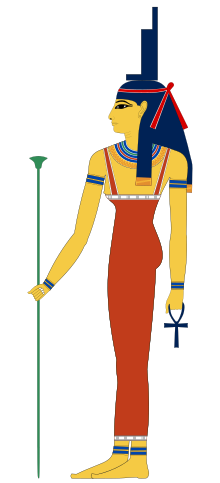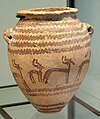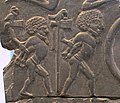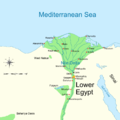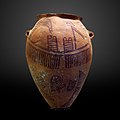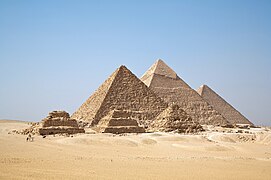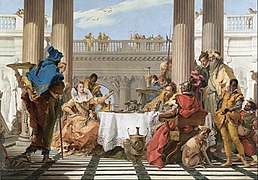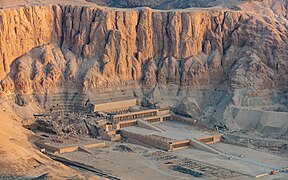Portal:Ancient Egypt
|
THE ANCIENT EGYPT PORTAL
Showcased content about Ancient Egypt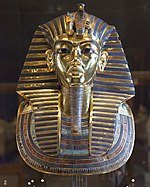 Ancient Egypt was a civilization of ancient Northeast Africa. It was concentrated along the lower reaches of the Nile River, situated in the place that is now the country Egypt. Ancient Egyptian civilization followed prehistoric Egypt and coalesced around 3100 BC (according to conventional Egyptian chronology) with the political unification of Upper and Lower Egypt under Menes (often identified with Narmer). The history of ancient Egypt unfolded as a series of stable kingdoms interspersed by periods of relative instability known as “Intermediate Periods.” The various kingdoms fall into one of three categories: the Old Kingdom of the Early Bronze Age, the Middle Kingdom of the Middle Bronze Age, or the New Kingdom of the Late Bronze Age. Ancient Egypt reached the pinnacle of its power during the New Kingdom, ruling much of Nubia and a sizable portion of the Levant. After this period, it entered an era of slow decline. During the course of its history, Ancient Egypt was invaded or conquered by a number of foreign powers, including the Hyksos, the Nubians, the Assyrians, the Achaemenid Persians, and the Macedonians under Alexander the Great. The Greek Ptolemaic Kingdom, formed in the aftermath of Alexander's death, ruled until 30 BC, when, under Cleopatra, it fell to the Roman Empire and became a Roman province. Egypt remained under Roman control until the 640s AD, when it was conquered by the Rashidun Caliphate. The success of ancient Egyptian civilization came partly from its ability to adapt to the conditions of the Nile River valley for agriculture. The predictable flooding and controlled irrigation of the fertile valley produced surplus crops, which supported a more dense population, and social development and culture. With resources to spare, the administration sponsored mineral exploitation of the valley and surrounding desert regions, the early development of an independent writing system, the organization of collective construction and agricultural projects, trade with surrounding regions, and a military intended to assert Egyptian dominance. Motivating and organizing these activities was a bureaucracy of elite scribes, religious leaders, and administrators under the control of a pharaoh, who ensured the cooperation and unity of the Egyptian people in the context of an elaborate system of religious beliefs.[1] The many achievements of the ancient Egyptians include the quarrying, surveying, and construction techniques that supported the building of monumental pyramids, temples, and obelisks; a system of mathematics, a practical and effective system of medicine, irrigation systems, and agricultural production techniques, the first known planked boats, Egyptian faience and glass technology, new forms of literature, and the earliest known peace treaty, made with the Hittites. Ancient Egypt has left a lasting legacy. Its art and architecture were widely copied, and its antiquities were carried off to far corners of the world. Its monumental ruins have inspired the imaginations of travelers and writers for millennia. A newfound respect for antiquities and excavations in the early modern period by Europeans and Egyptians has led to the scientific investigation of Egyptian civilization and a greater appreciation of its cultural legacy. (Full article...) Selected article -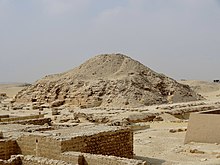 The pyramid of Unas (Egyptian: Nfr swt Wnjs "Beautiful are the places of Unas") is a smooth-sided pyramid built in the 24th century BC for the Egyptian pharaoh Unas, the ninth and final king of the Fifth Dynasty. It is the smallest Old Kingdom pyramid, but significant due to the discovery of Pyramid Texts, spells for the king's afterlife incised into the walls of its subterranean chambers. Inscribed for the first time in Unas's pyramid, the tradition of funerary texts carried on in the pyramids of subsequent rulers, through to the end of the Old Kingdom, and into the Middle Kingdom through the Coffin Texts that form the basis of the Book of the Dead. Unas built his pyramid between the complexes of Sekhemket and Djoser, in North Saqqara. Anchored to the valley temple at a nearby lake, a long causeway was constructed to provide access to the pyramid site. The causeway had elaborately decorated walls covered with a roof which had a slit in one section allowing light to enter, illuminating the images. A long wadi was used as a pathway. The terrain was difficult to negotiate and contained old buildings and tomb superstructures. These were torn down and repurposed as underlay for the causeway. A significant stretch of Djoser's causeway was reused for embankments. Tombs that were on the path had their superstructures demolished and were paved over, preserving their decorations. Two Second Dynasty tombs, presumed to belong to Hotepsekhemwy, Nebra, and Ninetjer, from seals found inside, are among those that lie under the causeway. The site was later used for numerous burials of Fifth Dynasty officials, private individuals from the Eighteenth to Twentieth Dynasties, and a collection of Late Period monuments known as the "Persian tombs". (Full article...)Selected picture
The Great Sphinx of Giza, partially excavated, with two pyramids in the background. Did you know...
News5th September 2018. Rock-cut Tomb discovered in a 4,000-year-old Elite Cemetery August 2018: in the tomb of the mayor of Memphis Ptahmose who dates around 1300 BC was found well preserved cheese, more than 3000 years old. [1] Selected biography -Isis was a major goddess in ancient Egyptian religion whose worship spread throughout the Greco-Roman world. Isis was first mentioned in the Old Kingdom (c. 2686 – c. 2181 BCE) as one of the main characters of the Osiris myth, in which she resurrects her slain brother and husband, the divine king Osiris, and produces and protects his heir, Horus. She was believed to help the dead enter the afterlife as she had helped Osiris, and she was considered the divine mother of the pharaoh, who was likened to Horus. Her maternal aid was invoked in healing spells to benefit ordinary people. Originally, she played a limited role in royal rituals and temple rites, although she was more prominent in funerary practices and magical texts. She was usually portrayed in art as a human woman wearing a throne-like hieroglyph on her head. During the New Kingdom (c. 1550 – c. 1070 BCE), as she took on traits that originally belonged to Hathor, the preeminent goddess of earlier times, Isis was portrayed wearing Hathor's headdress: a sun disk between the horns of a cow. In the first millennium BCE, Osiris and Isis became the most widely worshipped Egyptian deities, and Isis absorbed traits from many other goddesses. Rulers in Egypt and its southern neighbor Nubia built temples dedicated primarily to Isis, and her temple at Philae was a religious center for Egyptians and Nubians alike. Her reputed magical power was greater than that of all other gods, and she was said to protect the kingdom from its enemies, govern the skies and the natural world, and wield power over fate itself. (Full article...)General imagesThe following are images from various ancient Egypt-related articles on Wikipedia.
Related portalsWikiProjectsMain topics
Notable Pharaohs
CategoriesRecognized content
Featured articles
Featured listsGood articles
Did you know? articles
Featured pictures
In the News articlesMain page featured articles
Main page featured listsPicture of the day pictures
Things to do
WikimediaThe following Wikimedia Foundation sister projects provide more on this subject:
Sources
Discover Wikipedia using portals |



